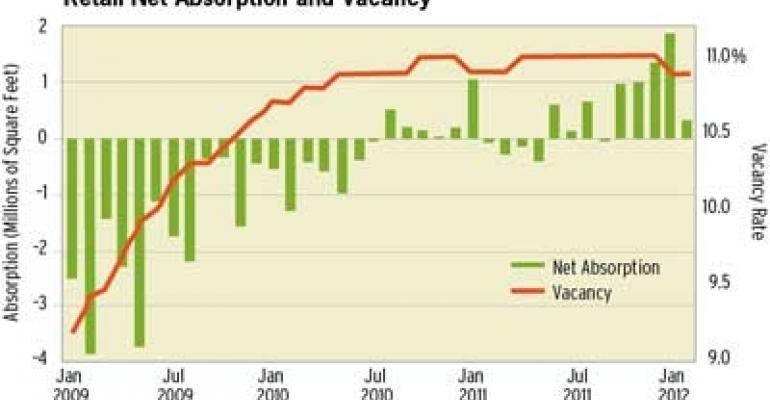In November 2010 we noted that retail fundamentals for neighborhood and community centers showed signs of bottoming, but that slow economic growth would continue, prompting vacancies to rise. The latest data through February 2012 provides evidence that a broad-based recovery for retail properties may finally have commenced.
Steadily Strengthening Absorption Figures
Consider the robust leasing patterns for neighborhood and community centers in the fourth quarter of 2011 and early 2012. Occupied stock increased by roughly 1 million sq. ft. per month, topping out at 1.36 million sq. ft. in December and 1.87 million sq. ft. in January. The sector has not absorbed this much space on a monthly basis since 2007.
Strong leasing patterns also pushed vacancies down by 10 basis points. Vacancies declined slightly to 10.9 percent in January 2012, unmooring itself from the 20-year high of 11.0 percent at which it was stuck for at least a year. Furthermore, both asking and effective rents rose by 0.1 percent in February, the first time both measures of pricing posted an increase since the first quarter of 2008.

To be fair, the sector also posted increases in occupied stock in late 2010 and early 2011, only for absorption to turn negative in the latter half of 2011. But signals were far more mixed then, with markets rattled by the European Union debt crisis and rents still posting declines. Now we are seeing vacancy declines not only for the neighborhood and community center subtype, but for various other retail property types as well.
Vacancies are falling faster for Other Retail Subtypes
Larger property types such as power centers boast 6.8 percent vacancies, a level that is fairly tight and that has declined consistently since mid-2010. Class-A malls, defined as regional malls that can command rents in the upper 75th percentile or higher of their specific metro, have vacancies of 6.4 percent, implying a slight but steady decline from that sector’s cyclical peak of 6.9 percent from mid-2009. REIT-controlled malls posted occupancy improvements through 2011. Grocery-anchored neighborhood and community shopping centers are also doing relatively better than properties anchored by other tenant types, with end-2011 vacancies at 7.5 percent versus the overall average of 11 percent.
This chart shows vacancy rate trends for different retail property subtypes, indexed to the first quarter of 2008. A trend towards vacancy declines starting at or around mid-2011 is evident, although the sector has some way to go before occupancies improve to levels last observed in early 2008, when the recession began.

Constrained Supply is a Boon
While demand drivers like increasing retail sales have been helpful, the dominant variable that is helping fuel the retail sector’s nascent recovery is constrained building. From 1999 to 2008 an average of 29 million sq. ft. of new shopping center space came online per year. That plunged to 13 million sq. ft. in 2009, and remained very low throughout 2010 and 2011. In fact, 4.5 million sq. ft. of new completions in 2010 represents the lowest figure for construction in Reis’s 30 years of history.
The US economy is expected to grow at a very modest 2.5 percent in 2012, which means we shouldn’t expect much of a boost from retail spending. Few retail tenants have plans to expand significantly, and many are still closing stores. But since the sector doesn’t have as much of a supply glut to deal with, vacancies are starting to come down, albeit slowly.
Risks in the Horizon
The retail recovery may well be here, but do not expect fundamentals to improve at a breakneck pace—unlike the apartment sector, which is benefiting from the headwinds of a moribund for-sale housing market. Expect vacancies to fall slowly, though some subtypes, including higher-quality malls and grocery-anchored centers, may outperform.
The biggest threat to the recovery is a slowdown in the pace of economic growth. Consider, for example, what increasing oil prices might do. Typically, GDP growth is shaved by 20 basis points for every 10 percent increase in the price of oil. Consensus forecasts for oil prices in 2012 suggest that despite a rising trend, the U.S. economic recovery should proceed largely unencumbered. However, a significant supply shock to oil prices stemming from escalating tensions involving Iran could put a stop to global economic growth and, with that, could dampen the prospects of retail recovery.
Victor Calanog is head of research and economics for New York-based research firm Reis.

